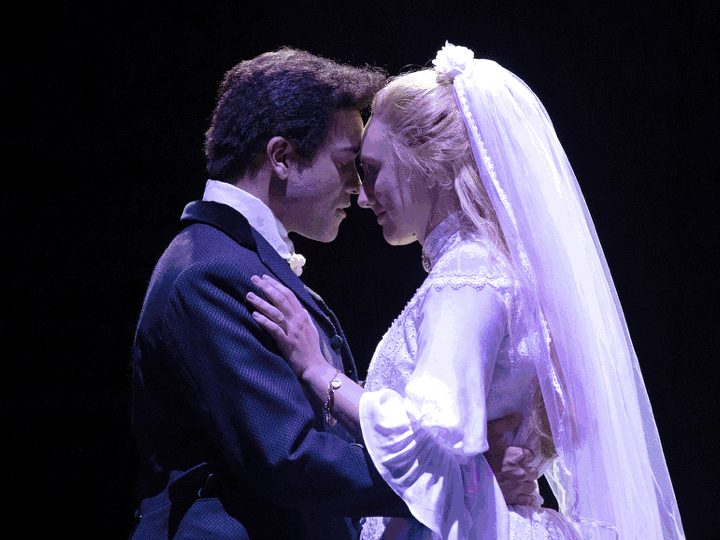Notes Don’t Stick in Throats of Tuvan Singers : Concert: Trio from tiny nation will perform in Santa Ana using khoomei, a technique allowing them to produce two or more tones simultaneously.
- Share via
When a Tuvan sings praises of mother and country, which is what a Tuvan usually sings, he often does it in three-part harmony.
By himself.
For while Western vocalists are content to produce a mere one note at a time, the multi-phonic vocal style known as “throat singing” is a skill that inhabitants of Tuva, the tiny nation between Outer Mongolia and Siberia, accomplish routinely.
The singing technique, called khoomei , actually (and seemingly miraculously) produces two or more distinct tones simultaneously.
“Hey, when you’re out on the steppes with nothing to do, you may as well sing a duet with yourself,” said Los Angeles resident Ralph Leighton, author of “Tuva or Bust!” and principal organizer of this month’s Southern California mini-tour by three throat-singing Tuvans.
Leighton’s book chronicles his and the late Richard Feynman’s 12-year efforts to visit Tuva after deciding that any place whose capital city--Kyzyl--includes no “respectable” vowels had to be an interesting place to visit. Feynman was an adventurer and Nobel laureate physicist.
Orange County residents will have the opportunity to hear this “music from the ends of the earth” today from 3 to 6 p.m. at Bowers Museum of Cultural Art in Santa Ana.
Bowers’ executive director Peter Keller, who was instrumental in finally arranging Leighton’s first journey to Tuva in 1988, has scheduled something of an old-fashioned Tuvan throat sing in a yurt--the circular felt and canvas tent in which the nomadic Tuvans live. A yurt will be set up inside the Bowers’ conference center the performance, the second in the museum’s Family Festival series. The event will feature a demonstration of Tuvan singing and harmonic styles, a slide show and Tuvan storytelling.
“Most male Tuvans throat sing just for the fun of it,” explained Rada Chakar, a Tuvan woman who is serving as translator for the singers, who arrived in the United States on Dec. 30 after a two-day flight from Tuva to Moscow to Los Angeles International Airport. (Their first order of business in the Southland was an appearance at the Rose Parade in Pasadena. Related story, F5.)
“They learn in the family. It’s not a matter of special teachers. On a national holiday, they all get up and throat sing together.”
Anyone in this country who has heard of Tuva (population: 380,000, Chakar said) probably is a stamp collector. The tiny country, earlier in the century known as Tannu Tuva, once issued more stamp designs--diamond and triangular shaped commemoratives--in a year than the United States and Great Britain combined.
The Tuvans’ Southland appearances, including the Rose Parade stint, are designed to help put Tuva back on the map, from which it disappeared--literally in many cases--during nearly half a century of Soviet rule.
Now enjoying greater autonomy since the collapse of the U.S.S.R., Tuva is in the process of selecting a new national anthem--and deciding whether it should be sung khoomei style.
At Hart Stables in Anaheim Hills, where the Tuvans were selecting steeds for the Rose Parade, they also proudly unfurled a proposed flag.
It took little prodding to elicit an impromptu throat-singing demonstration. The clanking of a horse being shod, far from hindering the singers, only seemed to inspire the performance; besides mother and country, horses and the Tuvan landscape are the most popular Tuvan song subjects.
The otherworldly music revealed an acute sense of the interplay of registers, with whistling warblings and flutterings dancing above a deep guttural drone not unlike a bullfrog--again, with all sounds issuing from the same voice.
It often sounded as if somebody had swallowed a jew’s-harp. Known as a khomus in the Tuvan’s Turkic tongue, the jew’s-harp is, in fact, an instrument the Tuvans use often, and it obviously inspired their vocal music.
While such a technique seems physically impossible to Westerners, there is a scientific explanation.
When people sing, every note includes both a fundamental tone that establishes the pitch as well as secondary overtones and harmonics that normally just provide color or timber to a tone. Thus Placido Domingo and Willie Nelson can sing the same note, yet sound quite different doing so.
In contrast, the khoomei style gives singers greater control over the volume of the harmonics such that the harmonic is as loud or louder than the fundamental pitch. Consequently, they can seem to be singing chords, and overtone melodies can be manipulated with amazing facility.
The origins of khoomei may lie in shamanism, a religious practice that seeks to summon good and evil spirits through inspired priests.
Though throat singing in Tuva is almost exclusively the domain of men, women are physically capable of producing the same phenomenon. According to liner notes from “Tuva: Voices From the Center of Asia” (Smithsonian Folkways Records), there has long been a taboo against women throat singers based on the belief that such singing could cause infertility in females. But that belief is gradually being abandoned, and some women are now learning khoomei.
“Throat singing seems to have served traditionally as a means of responding to states of heightened feeling brought on by exaltation at the beauty of nature,” the notes continue. “Walking alone on the grasslands, herders sang not for one another, but for themselves, for the mountains, and for the steppe.”
Indeed, throat singer Kongar-ool Ondar, standing idly by while his horse was being prepared, could be overheard throat singing to himself, and producing some of the most exotic sounds.
On this occasion, Ondar strummed a toshpulur, a three-stringed, fretted instrument, whose neck culminated with a horse-head scroll. Singing with him were Anatoly Kuular, who afterward offered an unearthly, and kaleidoscopically varied, a cappella performance, and Kaigal-ool Khovalyg, who recently was chosen to serenade the Dalai Lama during the religious leader’s visit to Tuva.
Practice time for throat singers is erratic at best. Because of the nomadic nature of the people, there are no real singing groups, as group members would change constantly.
Said Chakar: “If they practice at all, it is only when a concert date is looming. These three, for instance, have never before performed together. But they get together with different groups all the time.”
Ondar, Kuular and Khovalyg live in Kyzyl, wear modern outfits and sport Casio-style digital watches. Their parents, however, and many of their countrymen, remain nomadic and still wear the traditional Tuvan boots that curl up fancifully at the toes and hats that recall the dome and spire of Byzantine churches.
“During the Soviet period, Tuva became more Soviet,” Chakar said. “Now, things are changing again. Throat singing is becoming popular among the young people. All the people are going back to traditions.”
The Tuvan throat singers appear today at 3 p.m. at Bowers Museum of Cultural Art, 2002 N. Main St., Santa Ana. Tickets: $7.50, adults; $4 for children 12 and under. (714) 567-3600.
More to Read
The biggest entertainment stories
Get our big stories about Hollywood, film, television, music, arts, culture and more right in your inbox as soon as they publish.
You may occasionally receive promotional content from the Los Angeles Times.










